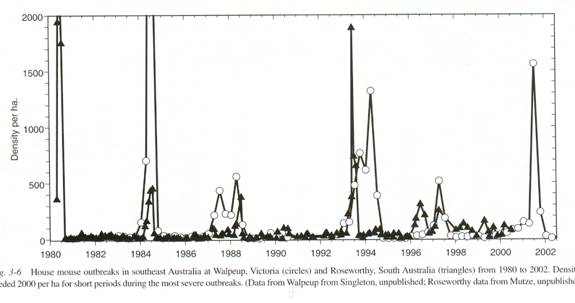Mouse plagues:
Occasionally, often in Australia or New Zealand, there is a phenomenon called a mouse plague. Here is a graph of one set of observations.

(The Mouse in Biomedical Research second edition Volume 1 History, Wild Mice and Genetics, chapter 3 “The Secret World of Wild Mice” section VI Population Dynamics part C. Population Eruptions (Mouse Plagues in Australia; population eruptions in New Zealand) Grant R. Singleton and Charles J. Krebs editors James G. Fox, Muriel T Davisson, Fred W. Quimby, Stephen W. Barhold, Chritian E. Newcomer and Abigail L. Smith Elsever Burlington 2007 page 39. The caption reads: House mouse outbreaks in southeast Australia at Walpeup, Victoria (Circles) and Roseworthy, South Australia (Triangles) from 1980 to 2002. Densities exceeded 2,000 per ha (hectare) for short periods during the most severe outbreaks. Data from Walpeup from Singleton, unpublished; Roseworthy data from Mutze, unpublished.) At some time, typically about a year after a drought, the number of mice in an area increases spectacularly. Of course they get into everything.
It is noticed that during mouse plagues behavior changes. Usually mice are territorial, the male chasing intruders out of his area. But as the density of the mice increases there comes a point where they do not do this. Any mouse goes anywhere without being challenged. Then suddenly they are gone. Afterwards mice are quite rare in the area for a while.
It is the sudden disappearance that is the mystery. Where they come from is no mystery, they are breeding very rapidly. Possibilities for the cause of their disappearance that have been entertained have included:
- Predators. But there are so many mice that predators are thought not to be capable of putting a dent in the population.
- No food. But the plague ends often when food is still abundant.
- Fighting. But the mice are not seen to be wounded.
- Disease. That’s the going theory. It is thought that the excessive outbreeding somehow weakens the immune system and papova virus overwhelms them.
The whole process takes about a year, sometimes with a rebound. And maybe it is a virus that ends it, although it seems to me that we are usually told that it is inbreeding that weakens an immune system not outbreeding. It seems odd that the virus should be waiting in the wings to move in at just the right time, but possible I suppose. What has not been produced is a collection of mice toward the end of the plague all ridden with the virus.
I think it’s the drought. The mice usually live in equilibrium with their environment, and that equilibrium is reinforced by the well established fact that fertility drops as population size rises. The drought kills a lot of mice. The survivors have a smaller than usual available mating pool and some die out because of the resulting inbreeding. But some get just the right amount of inbreeding for maximal fertility. The number of mice skyrockets and the social norms break down. Soon mice are mating helter-skelter. This after a very few generations reduces their fertility to nearly zero. But there is still a large pool of fertile mice surviving from the period of maximal fertility. So the number of mice still goes up. Eventually the fertile mice die. I do not know what the generation time of wild mice is. I do not know how long they live in the wild, but it is probably a lot more brief than their life span in a cage. So the area is overrun with infertile mice with falling fertility. When that catches up with them, the population goes down very rapidly. Even the few that are still fertile are only marginally so; the mice become rare.
Go back and look at the graph. The plagues last about a year. If the numbers do not go too terribly high, that is when you can get a rebound. And on two occasions the rebound is higher than the original peak but narrower, for all the world like the experience of Long House Valley. http://www.nobabies.net/Albuquerque%20poster.html looking at the tenth graph.
It ought to be possible to test the idea. Catch some wild mice at the height of the plague and check their fertility. It ought to be very low.
If my surmise is correct, then it would seem that humans are now in plague mode. The usual restrictions to mating pool size are gone, partly for technological reasons and partly for social reasons. Like mice during the plague, humans are rather indifferent to outsiders. That is a good thing for all purposes but one. And that one purpose attracts little attention. Nobody likes a plague after all.
There have been 4,062 visitors so far.
Home page.
